Starmer’s pre-election plan? Dance a gentle waltz with the media

In the run up to a general election, a curious metaphorical dance takes place between the party in opposition and the UK media.
Those gyrations were put on hold in 2017 and 2019 when Labour’s Jeremy Corbyn refused to be seen as breaking bread with the enemy. But this time round, with the finish line on this five-year marathon almost in view, the courtship between Labour and the media is getting pretty steamy.
Labour leader Sir Keir Starmer has been on a roll in recent months with columns in newspapers and long-form interviews, including with those who have been hostile towards him.
Just this week his immigration proposals have been played out in full and given serious, rigorous scrutiny. Yes, some newspapers think they are unworkable and even an affront to Brexit. But at least they are talking about the plans instead of simply dismissing them out of hand.
Starmer’s efforts to court the media are reminiscent of Tony Blair’s attempts to secure backing from the Sun newspaper in the 1997 election. This included a trip by Blair to Australia for an audience with Rupert Murdoch.
The current Labour leadership is not quite at that level of fawning but ever since Starmer wrote a column in the Sun in 2021 – much to the distain of Liverpool residents and some of his own MPs – there has been a noticeable shift in relations across the media spectrum.
This is not a one-sided affair: the media knows it too must play its part, for its own sake.
Mudoch’s reasoning for supporting Labour in 1997 came down to the newspaper baron wanting to pick a winner and appear on the right side of history. Knowing he picked the right side no doubt helped keep the door to Number 10 ajar for the occasional meeting to discuss commercial interests.
Starmer is seeing this same shift – albeit in a more muted fashion – as those on Fleet Street watch the stars align, knowing he has a strong chance of being at the levers of power.
The industry also knows there is a commercial rationale to maintaining the courtship because bosses will want to ensure no nasty regulations could be on their way as punishment for perceived biases.
This was something they feared under a possible Corbyn government intent on implementing the Leveson Inquiry’s recommendations and almost played out when the Conservatives attempted to privatise Channel 4, partly in response to the party’s dislike of Channel 4 News.
Labour leaders since Blair have tried to keep close with the media – especially since the industry has a greater distrust that the party in red is more likely to stifle the commercial viability of the sector compared to the Tories.
But that all changed with Corbyn, who vowed to no longer dance to the sector’s tune during his time at the helm of the party.
From the off, Corbyn ecided framing the media as the enemy would help galvanise his supporters – as Donald Trump would subsequently do.
This frosty dynamic meant the industry realised the courtships of old could not work.
In the 2019 election campaign, Boris Johnson was equally disdainful, famously deciding to dive into a fridge rather than face questions from Good Morning Britain.
Attacking the media will only get you so far.Starmer is not adopting the exuberant love-bombing of Blair, nor the outright loathing of Cor byn. Instead he is finding a third way with tentative signs of affection.
His efforts are starting to be reciprocated too. Labour’s pragmatic approach is allowing its views to be heard more widely and building a narrative that Starmer is a man looking for consensus.
Meanwhile, the traditional media can see how this dance ends, knowing it must also portray itself as pragmatic and sensible too.
Scrutiny will remain but editors know they must save some firepower for when the real challenge begins in holding the next potential Labour Government to account as their policies are turned into laws.